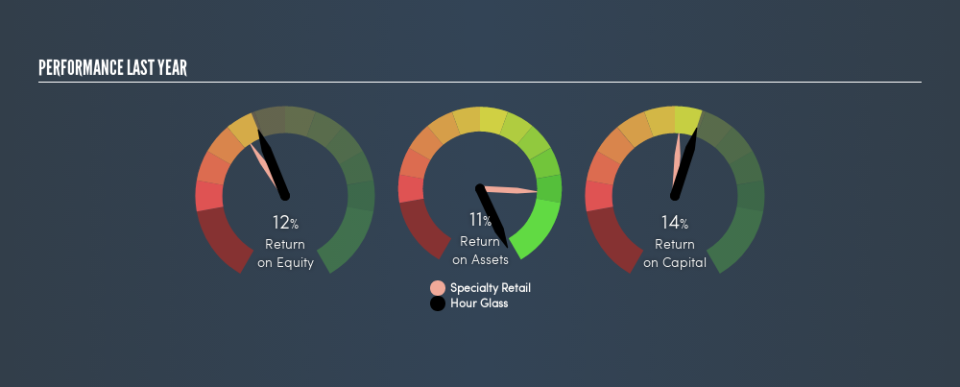Why You Should Like The Hour Glass Limited’s (SGX:AGS) ROCE

Today we'll evaluate The Hour Glass Limited (SGX:AGS) to determine whether it could have potential as an investment idea. In particular, we'll consider its Return On Capital Employed (ROCE), as that can give us insight into how profitably the company is able to employ capital in its business.
First up, we'll look at what ROCE is and how we calculate it. Second, we'll look at its ROCE compared to similar companies. And finally, we'll look at how its current liabilities are impacting its ROCE.
Understanding Return On Capital Employed (ROCE)
ROCE measures the 'return' (pre-tax profit) a company generates from capital employed in its business. Generally speaking a higher ROCE is better. Overall, it is a valuable metric that has its flaws. Renowned investment researcher Michael Mauboussin has suggested that a high ROCE can indicate that 'one dollar invested in the company generates value of more than one dollar'.
How Do You Calculate Return On Capital Employed?
The formula for calculating the return on capital employed is:
Return on Capital Employed = Earnings Before Interest and Tax (EBIT) ÷ (Total Assets - Current Liabilities)
Or for Hour Glass:
0.14 = S$81m ÷ (S$649m - S$73m) (Based on the trailing twelve months to March 2019.)
Therefore, Hour Glass has an ROCE of 14%.
See our latest analysis for Hour Glass
Is Hour Glass's ROCE Good?
ROCE is commonly used for comparing the performance of similar businesses. In our analysis, Hour Glass's ROCE is meaningfully higher than the 11% average in the Specialty Retail industry. I think that's good to see, since it implies the company is better than other companies at making the most of its capital. Independently of how Hour Glass compares to its industry, its ROCE in absolute terms appears decent, and the company may be worthy of closer investigation.
You can click on the image below to see (in greater detail) how Hour Glass's past growth compares to other companies.
When considering ROCE, bear in mind that it reflects the past and does not necessarily predict the future. Companies in cyclical industries can be difficult to understand using ROCE, as returns typically look high during boom times, and low during busts. ROCE is only a point-in-time measure. If Hour Glass is cyclical, it could make sense to check out this free graph of past earnings, revenue and cash flow.
How Hour Glass's Current Liabilities Impact Its ROCE
Liabilities, such as supplier bills and bank overdrafts, are referred to as current liabilities if they need to be paid within 12 months. The ROCE equation subtracts current liabilities from capital employed, so a company with a lot of current liabilities appears to have less capital employed, and a higher ROCE than otherwise. To counteract this, we check if a company has high current liabilities, relative to its total assets.
Hour Glass has total assets of S$649m and current liabilities of S$73m. As a result, its current liabilities are equal to approximately 11% of its total assets. Current liabilities are minimal, limiting the impact on ROCE.
Our Take On Hour Glass's ROCE
This is good to see, and with a sound ROCE, Hour Glass could be worth a closer look. Hour Glass shapes up well under this analysis, but it is far from the only business delivering excellent numbers . You might also want to check this free collection of companies delivering excellent earnings growth.
If you like to buy stocks alongside management, then you might just love this free list of companies. (Hint: insiders have been buying them).
We aim to bring you long-term focused research analysis driven by fundamental data. Note that our analysis may not factor in the latest price-sensitive company announcements or qualitative material.
If you spot an error that warrants correction, please contact the editor at editorial-team@simplywallst.com. This article by Simply Wall St is general in nature. It does not constitute a recommendation to buy or sell any stock, and does not take account of your objectives, or your financial situation. Simply Wall St has no position in the stocks mentioned. Thank you for reading.

